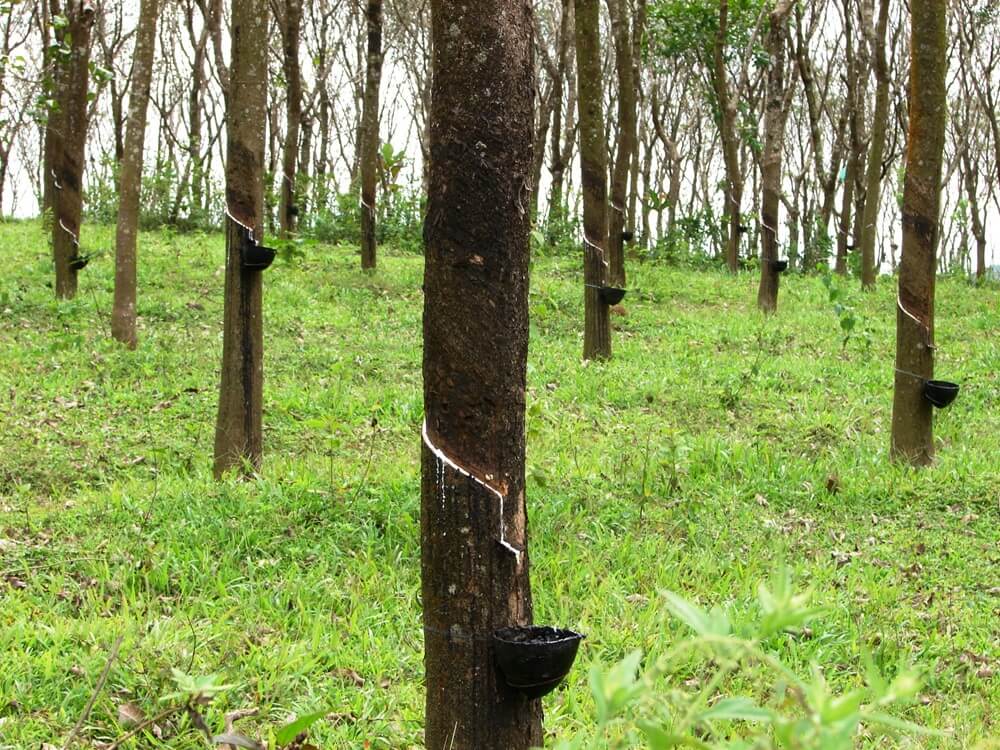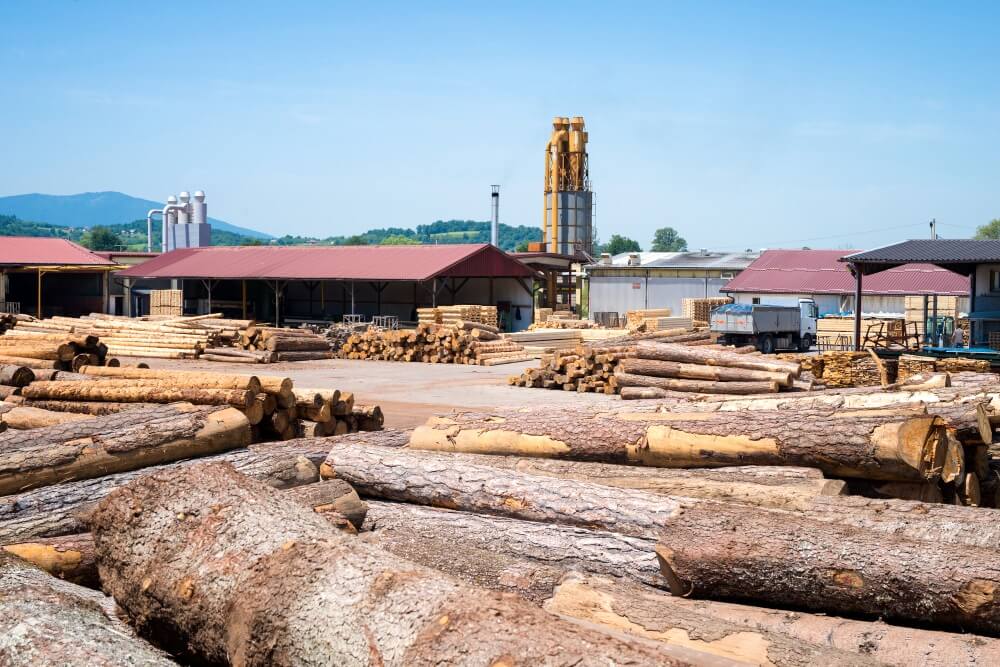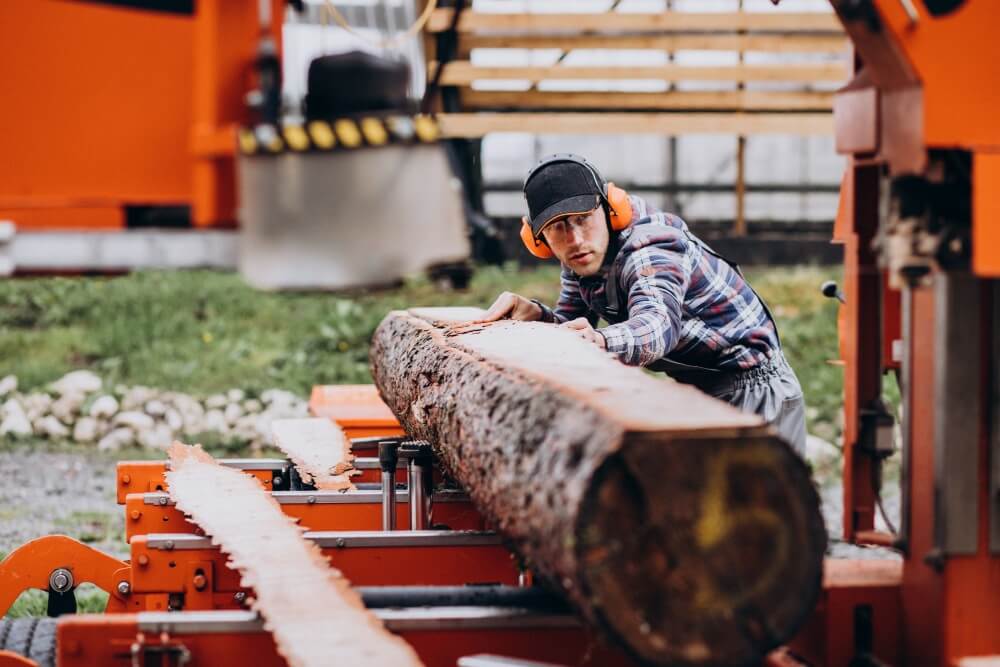Natural rubber comes from the milky latex of certain trees (mainly Hevea brasiliensis) and is also produced synthetically by polymerizing monomers. Historically native to the Amazon, commercial cultivation moved to Southeast Asia in the late 19th and early 20th centuries; today Asia supplies the majority of the world’s natural rubber.
Natural rubber plantations typically begin producing economically from about year six and remain productive for decades. Processing turns fresh latex into storable, marketable forms such as sheets, crepes, and block rubber used across industries.
Where Rubber Grows Best
Ideal conditions for natural rubber include locations within roughly 8°N to 10°S of the Equator, warm temperatures (near 28°C), high humidity, well-distributed annual rainfall (roughly 1,500–2,000 mm), and altitudes below 400 meters. Soils should be deep with good drainage and moisture-holding capacity.
Main Uses of Natural Rubber
Natural rubber is used in a wide range of applications including vehicle tires and tubes, conveyor belts, footwear, industrial hoses, seals and gaskets, medical gloves, and many molded rubber goods. Its key material properties are high elasticity, tensile strength, abrasion resistance, and good performance over a broad temperature range.

Types of Rubber
Natural rubber — extracted from latex — and synthetic rubber — manufactured chemically — together satisfy global demand. Natural rubber is preferred in applications that require high resilience and tear resistance (e.g., tires, some industrial products), while synthetics dominate in engineered blends and specialty uses.
Global Production — 2024–2025 Snapshot
Global natural rubber production has been relatively stable but tight relative to demand. Industry groups and news reports note production constraints in 2024 and early 2025 and a possible global shortfall in 2025 due to stagnant output in key producing countries and growing demand from tire and auto sectors.
Regional production remains concentrated in Southeast Asia, with Thailand, Indonesia, and Vietnam accounting for the largest shares. FAO and industry datasets show that Thailand continues to lead global production while other countries such as India, China, and Cote d’Ivoire also contribute significant volumes.
Top 10 Natural Rubber Producing Countries (2024–2025 estimates)
Below are the leading producers based on the latest 2023–2025 public datasets and industry reports (rounded figures):
- Thailand — ~5.0–5.3 million metric tons (largest global producer; slight year-to-year variation due to weather and area harvested). European Forest Institute+1
- Indonesia — ~2.0–3.1 million metric tons (major producer; output faced pressures in 2024–2025 from crop shifts in some areas). anrpc.org+1
- Vietnam — ~1.2–1.3 million metric tons (rapidly growing exporter and important Southeast Asian supplier). VietnamExportData+1
- India — ~1.0–1.1 million metric tons (Kerala remains the traditional center; northeastern states are expanding production). The Economic Times+1
- China — ~0.7–0.9 million metric tons (domestic demand is large; China imports substantial volumes for processing). ReportLinker+1
- Côte d’Ivoire (Ivory Coast) — ~1.2–1.35 million metric tons (West Africa growing fast as producers expand acreage). ReportLinker
- Malaysia — ~0.47 million metric tons (declines in plantation area have reduced output versus historical highs). Science Agri
- Philippines — ~0.15–0.20 million metric tons (growing production in some coastal and southern provinces). ReportLinker
- Nigeria — ~0.15 million metric tons (expanded production in several states; Nigeria is a notable African producer). ReportLinker
- Sri Lanka — ~0.07–0.08 million metric tons (smaller but historically significant producer). ReportLinker

These figures mix FAO, national reports, and industry estimates — small differences across sources are normal due to reporting lag and seasonal factors. For example, the Association of Natural Rubber Producing Countries (ANRPC) and Reuters reported that 2025 production growth is constrained while demand was projected to rise, tightening the market. anrpc.org+1
Country Notes (what to watch)
- Thailand: Remains the world leader; production can vary with monsoon patterns and tree age/planting cycles. Recent analyses put Thailand production around the 4.7–5.3 million tonne range in recent data series. European Forest Institute+1
- Indonesia: Large planted area but yields vary; pressures in 2024–2025 include some farmers switching land to more profitable crops (e.g., palm oil) and adverse weather in parts of the country. Reuters+1
- Vietnam: Fast growth in planted area and improved agronomy has made Vietnam a significant exporter; exports to China and other markets rose in recent years. VietnamExportData
- India: Production rising in the northeast and through state-level initiatives; domestic tyre manufacturing has increased demand for locally grown rubber. The Economic Times
- China: Large consumer of rubber; domestic plantations supply part of demand but imports remain essential for industrial processing. Reuters
- West Africa (Côte d’Ivoire, Liberia, Cameroon): Increasing role in global supply as investments in plantation expansion and processing grow. ReportLinker
Production Drivers and Constraints
Key physical and economic factors that determine rubber production include climate, soil, water availability, skilled labour, capital, infrastructure, and access to markets. In 2024–2025, the sector faced a combination of weather disruptions (heavy rains, typhoons), shifting farmer incentives, and supply constraints — contributing to elevated rubber prices in late 2024 and a tight market outlook into 2025.

Uses & Forms
Natural rubber is converted into sheets, crepes, technically specified rubber (TSR), and concentrated latex. The largest end-use remains tyres and tubes for the automotive industry; other important uses include industrial belts, footwear, hoses, and medical products.
Environmental and Market Trends (2024–2025)
Sustainability, yield improvement, and diversification are major themes. Buyers increasingly demand traceability and sustainable practices — and producers face pressure to improve yields and reduce conversion to other land uses. Also, higher rubber prices in 2024–2025 spurred interest in expanding plantations in West Africa and parts of South America, though scale-up takes time.
FAQs
Which country produces the most natural rubber in 2025?
Thailand remains the largest producer, with multi-million-ton output and the biggest plantation area among producing nations.
Is global rubber supply tight in 2024–2025?
Yes — industry reports and producers’ groups warned of a potential shortfall in 2025 as production growth lags demand growth, pushing prices higher.
Can other regions replace Southeast Asia as a major rubber source?
West Africa and parts of South America are expanding, but replacing Southeast Asia’s infrastructure and experience would take time and investment.
What are the main uses of natural rubber?
Tyres and tubes dominate demand, followed by industrial belts, footwear, hoses, and a growing range of medical and technical products.
Bottom Line
Southeast Asia continues to dominate global natural rubber production, with Thailand, Indonesia, and Vietnam as the top suppliers. The 2024–2025 period shows a tight market picture: weather disruptions, farm economics, and steady industrial demand have kept supplies constrained and prices firm. For businesses and buyers, that means closer attention to sourcing, sustainability, and risk management across supply chains.
Sources (key references used for data & trends)
- FAO statistical yearbook and country production tables (FAO, 2023–2024 releases). Open Knowledge FAO+1
- ANRPC / industry outlook and production commentary (2024–2025). anrpc.org
- Reuters reporting on 2024 supply constraints and price movements. Reuters
- Country production datasets and market overviews (reportlinker / industry compilations). ReportLinker
- Recent country-specific export and production notes (Vietnam export data source). VietnamExportData

Daniel is a business writer focused on entrepreneurship, finance, and investment strategies. He shares practical insights to help professionals and business owners make informed decisions in a fast-changing market.
Leave a Reply